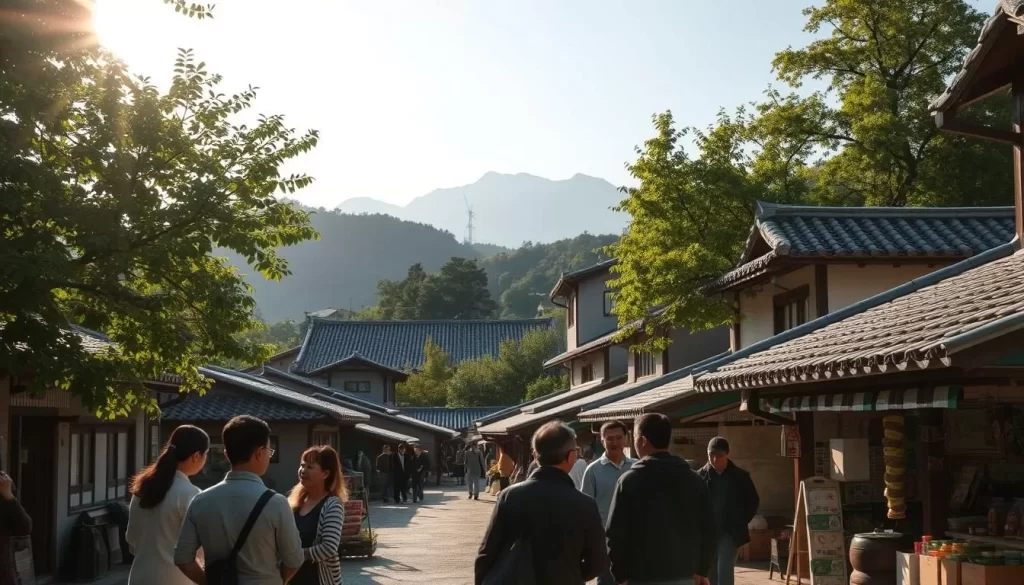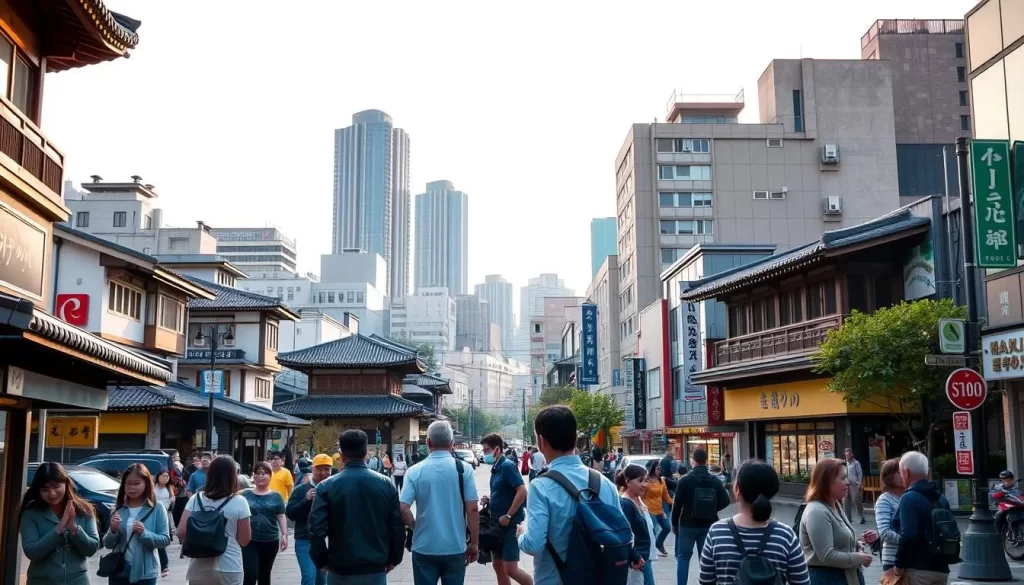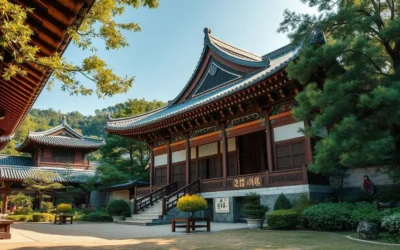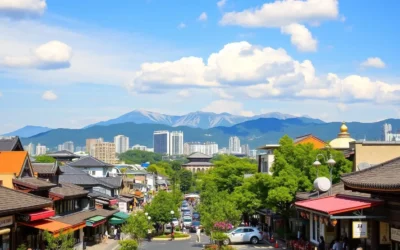✓ Accommodations✓ Flights✓ Rental Cars
As you explore the culturally rich region of South Jeolla Province in South Korea, you’ll uncover a distinctive linguistic identity that is deeply rooted in the country’s history and heritage.
The korean language is the cornerstone of communication across the peninsula, with its unique alphabet, Hangul, and a grammar system that reflects the nation’s past.
In South Jeolla Province, the Jeolla dialect adds a layer of cultural richness, showcasing the region’s historical development and cultural heritage.
Understanding the language landscape here is essential for anyone interested in the region’s culture and society, as it reflects both tradition and modernity.
The Linguistic Landscape of South Korea
Understanding the linguistic landscape of South Korea requires a deep dive into the Korean language, which has been shaped by centuries of history and cultural influences. As the primary language spoken in South Korea, Korean is not just a means of communication but also a symbol of national identity.
Korean as the National Language
The Korean language is the official language of South Korea and is spoken by the vast majority of the population. It is a unique language with its own writing system, known as Hangul, which was created in the 15th century to promote literacy among the general population. Today, Korean is an integral part of daily life, used in all aspects of society, from education to government and media.

Historical Development of Korean Language
The historical development of the Korean language is a story of evolution and adaptation. Initially, Korean was written using Chinese characters, known as Hanja, which limited literacy to the elite. However, with the introduction of Hangul by King Sejong in the 15th century, the language became more accessible to the general population. Over time, Korean continued to evolve, absorbing influences from Chinese and other languages while maintaining its distinct grammatical structure. The division of the Korean peninsula into North and South Korea after the Korean War led to some divergence in language variants between the two regions.
Despite these changes, the core structure and characteristics of the Korean language have remained remarkably consistent, allowing modern Koreans to read historical texts written in Hangul. This balance between tradition and modernity is a hallmark of the Korean language, reflecting the country’s cultural pride and identity.
South Jeolla Province: Regional Overview
As you explore South Jeolla Province, you’ll discover a region rich in history, culture, and linguistic diversity. This southwestern Korean province is not only known for its breathtaking landscapes but also for its significant role in the development of the Korean language.
Geographical and Cultural Context
South Jeolla Province is characterized by its diverse geography, which has influenced the local culture and dialect. The region’s unique cultural heritage is reflected in its traditional arts, such as pansori (narrative singing), which has helped preserve archaic language forms.

Historical Significance in Korean Language Development
The province has played a crucial role in the historical development of the Korean language, particularly during the Three Kingdoms period. Its historical separation from capital regions contributed to the preservation of older linguistic features in the Jeolla dialect. Historical events, including Japanese occupation and the Korean War, have also impacted language use in the region over time.
- The region preserved traditional Korean language elements lost in other areas.
- Historical resistance movements influenced certain linguistic expressions.
- Trading relationships with other regions affected dialect development.
The Jeolla Dialect: Characteristics and Usage
The Jeolla dialect is a fascinating aspect of Korean language diversity, with its own set of vocabulary, pronunciation, and use. Spoken in South Jeolla Province, it reflects the region’s unique cultural and historical context.
Distinctive Features
The Jeolla dialect is characterized by several distinctive features. One notable aspect is its unique verb endings, such as ‘burida,’ which adds emphasis to a sentence. The dialect also employs the ‘-ing’ (잉) sound when asking questions or making suggestions, giving it a distinct intonation.
Pronunciation Differences
Pronunciation in the Jeolla dialect differs significantly from Standard Korean. Speakers of the Jeolla dialect tend to use many exclamatory expressions, making their speech more emotive and expressive. The pronunciation differences are not just limited to intonation but also extend to the way certain words are articulated.
Vocabulary Unique to Jeolla
The Jeolla dialect boasts a rich vocabulary that is unique to the region. Terms like ‘geoshigi’ (거시기), used when forgetting a word, similar to saying “that thing” in English, are common. The dialect preserves some archaic Korean words that have fallen out of use in Standard Korean, offering a glimpse into the language’s historical development. Some everyday objects and traditional industries have completely different names in the Jeolla dialect, reflecting the region’s cultural heritage.
Learning some unique Jeolla terms can help you connect more deeply with locals and show respect for the regional culture. The dialect is not just a means of communication; it’s a bridge to understanding the history and identity of South Jeolla Province’s speakers.
Comparing Jeolla Dialect with Standard Korean
A comparison between the Jeolla dialect and Standard Korean reveals insights into the linguistic diversity of South Korea. While Standard Korean is the official language used in formal settings, education, and media across the country, the Jeolla dialect is a significant part of the regional identity.
Mutual Intelligibility
The Jeolla dialect and Standard Korean are mutually intelligible to a certain extent, as they share a substantial amount of vocabulary and grammatical structures. However, differences in pronunciation, intonation, and some vocabulary can sometimes lead to misunderstandings or require additional context for clear understanding.
Speakers of Standard Korean may find it relatively easy to comprehend the Jeolla dialect, especially in formal or official contexts where Standard Korean influences are more pronounced.
Cultural Perceptions and Stereotypes
The Jeolla dialect is often portrayed in South Korean media as warm and expressive, characterizing characters as friendly or traditional. However, historical regional tensions have sometimes led to linguistic discrimination against Jeolla dialect speakers.
| Characteristics | Jeolla Dialect | Standard Korean |
|---|---|---|
| Pronunciation | Distinctive intonation and vowel pronunciation | Neutral intonation, standardized pronunciation |
| Vocabulary | Unique regional words and expressions | Standardized vocabulary, widely understood |
| Cultural Association | Associated with traditional music like pansori | Used in formal settings and media |

Efforts to promote positive representations of the Jeolla dialect in contemporary media and education are underway, challenging negative stereotypes and appreciating regional linguistic diversity.
South Jeolla Province, South Korea: Official and Widely Spoken Languages
The linguistic diversity of South Jeolla Province is a reflection of its cultural heritage and regional identity. As a region in South Korea, it is subject to the country’s official language policies while maintaining its unique dialectical variations.
Official Language Policies
South Korea’s official language is Korean, and Standard Korean is the variant used in official contexts, education, and media across the country, including South Jeolla Province. Language policies are designed to promote the use of Standard Korean, ensuring national unity and communication across different regions. However, the province also acknowledges and respects its regional dialect, known as the Jeolla dialect.
The high literacy rate in South Jeolla Province, consistent with South Korea’s national average of 99%, supports the widespread use of Standard Korean. Modern communication technologies have also played a significant role in promoting Standard Korean, as they often favor standardized language forms.
Language Demographics in South Jeolla
Demographic statistics reveal interesting patterns in language use within South Jeolla Province. While most of the population is fluent in Standard Korean, the Jeolla dialect remains vibrant, especially in rural areas. Language use varies significantly across different age groups, with older generations using the regional dialect more extensively than younger people.
| Demographic Group | Primary Language/Dialect | Percentage |
|---|---|---|
| Older Generations (65+) | Jeolla Dialect | 70% |
| Younger Generations (18-64) | Standard Korean | 60% |
| Rural Areas | Jeolla Dialect | 55% |
| Urban Centers | Standard Korean | 80% |
The urban-rural divide is also notable, with rural areas maintaining stronger dialect features compared to urban centers. Education levels correlate with dialect use, as higher education often results in increased use of Standard Korean alongside the regional dialect. Migration patterns, including both out-migration of younger residents and in-migration from other regions, also impact language demographics.

English and Foreign Language Presence
As you explore South Jeolla Province, you’ll notice the diverse linguistic landscape that includes English and other foreign languages. The region’s embrace of globalization has led to an increased presence of foreign languages in education, business, and daily life.
English Education and Proficiency
English education is a significant part of the curriculum in South Jeolla Province, reflecting the region’s efforts to engage with the global community. Schools and private institutions offer various English language programs, from basic language skills to specialized courses in business English.
English proficiency among the population has been on the rise, driven by the importance of English in international business, education, and tourism.
Other Foreign Languages in South Jeolla
Beyond English, other foreign languages such as Chinese, Japanese, and Vietnamese are also present in the region. The historical and cultural ties between Korea and these countries have contributed to the linguistic diversity.
| Language | Influence | Usage |
|---|---|---|
| Chinese | Economic ties and cultural exchange | Business, education, and cultural events |
| Japanese | Historical and cultural legacy | Tourism, business, and language education |
| Vietnamese | Increasing migrant worker population | Community interactions and cultural events |
Language Evolution and Modern Influences
The Jeolla dialect, a cornerstone of South Jeolla Province’s cultural identity, is evolving in response to modern influences. As you explore this evolution, it becomes clear that the dialect is being shaped by various factors, including media and technology.
Impact of Media and Technology
Modern media and technology are significantly impacting the Jeolla dialect. The widespread use of social media, online content, and digital communication platforms is introducing new vocabulary and influencing pronunciation. This digital shift is not only changing how people interact with the dialect but also how it’s perceived by younger generations.
Preservation Efforts for Regional Dialect
Efforts to preserve the Jeolla dialect are multifaceted. Local governments, cultural institutions, and educational organizations are working together to document and promote the dialect. Community-based initiatives, such as dialect contests and cultural events, are also playing a crucial role. Moreover, academic research and linguistic documentation projects are recording and analyzing the dialect for future generations, ensuring its place within the region’s cultural heritage.
Comparing these efforts with those for other endangered Korean dialects, like the Jeju dialect, highlights the challenges faced in preserving regional dialects in the face of urbanization and standardized education.
Practical Language Tips for Visitors and Expats
As you explore South Jeolla Province, understanding the local dialect can greatly enhance your experience. While Korean is the official language, the Jeolla dialect has its unique characteristics that can be fascinating to learn.
Essential Phrases in Jeolla Dialect
Learning a few essential phrases in the Jeolla dialect can help you connect with the local people. Start with basic expressions like greetings and introductions. For instance, saying “annyeonghaseyo” (hello) or “gamsahamnida” (thank you) can go a long way in showing respect for the local culture. You can also try using dialect-specific words to create a deeper appreciation for the region’s heritage.
Navigating Language Barriers
When encountering the Jeolla dialect, don’t be afraid to ask for clarification or request slower speech. Many locals appreciate visitors making an effort to communicate in their dialect, even if it’s not perfect. You can also rely on technology, such as translation apps, to help bridge the language gap. In major cities like Mokpo, Yeosu, and Suncheon, you’ll find more English-speaking services, making it easier to navigate everyday situations. Whether you’re shopping or dining, being open to learning and using local phrases can lead to more meaningful interactions with the people you meet.
Conclusion
South Jeolla Province’s language landscape is characterized by the coexistence of Standard Korean and the Jeolla dialect. The Jeolla dialect is a vital part of the region’s cultural heritage, with unique characteristics that distinguish it from Standard Korean. Understanding this linguistic diversity enhances your appreciation of the region’s culture, history, and people. The balance between tradition and modernity is evident in the province’s language use, with efforts to preserve dialect features alongside adaptations to contemporary communication needs. As language continues to evolve in response to social, technological, and global influences, the future of language diversity in South Jeolla Province will depend on ongoing preservation and standardization efforts. By engaging with the local language, you can deepen your connection to this vibrant region. Language in South Jeolla Province, like throughout the Korean peninsula, is both a practical tool for communication and a living expression of cultural identity.
The above is subject to change.
Check back often to TRAVEL.COM for the latest travel tips and deals.






